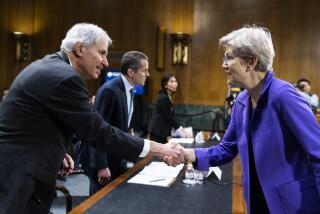200 Solvent S&Ls; Expected to Fail in Next 2 Years : 400 Others in Jeopardy if They Can’t Raise Capital, Administration Estimates
WASHINGTON — White House Budget Director Richard Darman, giving a preview of a drastically altered savings and loan industry, said Thursday that the Bush Administration expects 200 currently solvent S&Ls; to fail within the next two years, in addition to the 345 insolvent institutions already slated for shutdown or sale.
Another 400 thrifts face likely extinction if they cannot raise additional capital to meet the tough new financial standards proposed by the Administration as part of its S&L; rescue package, Darman told the Senate Banking Committee.
Industry analysts have been predicting a drastic shrinkage of the troubled S&L; industry, which totaled about 3,000 institutions as of mid-1988, before the closure or merger of 223 of them.
But Darman is the first Administration official to offer such a forecast, and independent analysts said he might be underestimating the potential industry shakeout. Bert Ely, a consultant in Alexandria, Va., predicted that as many as 800 to 900 more S&Ls; could be wiped out, compared to Darman’s 600.
Darman also warned that the ultimate costs of the Bush program to dispose of insolvent S&Ls; and guarantee deposits up to $100,000 could balloon beyond the current estimate of $94 billion from taxpayers during the full 33-year period of paying off the bonds that would finance the rescue.
If the Administration had to offer higher-than-estimated interest rates on the bonds, Darman said, that could add substantially to repayment costs.
Senate Banking Committee Chairman Donald W. Reigle Jr. said the Administration seemed to be asking Congress to write “a blank check” to finance the bailout.
Darman responded: “That obligation and the (deposit) insurance are already there.”
The exchange demonstrated the only certainty in the fast-changing S&L; debate: The federal government will honor its promise to protect deposits up to $100,000. The disappearance of hundreds of S&Ls; from the beleaguered industry, accompanied by the closing of thousands of branch offices, will not jeopardize depositors with insured savings.
Meanwhile, federal regulators continued their campaign of seizing control of insolvent institutions. The thrifts are placed under conservatorships, allowing regulators to have ultimate control of key business decisions on interest rates, mortgage charges and investment policies.
The Federal Deposit Insurance Corp. took control of 37 institutions in six states, bringing to 73 the total number of thrifts brought under the agency’s control since President Bush announced his bailout plan last month.
In Thursday’s action, the biggest to date, the FDIC seized 12 S&Ls; in Texas, 10 in Kansas, eight in Arkansas, four in Louisiana, two in Alaska and one in Maryland. They have total assets of $7.9 billion.
Darman’s disclosure before the Senate committee set the stage for a fierce political battle between the S&L; industry and the banking business.
The healthy S&Ls;, already burdened by a heavy premium for their federal deposit insurance, want extra time to meet the new capital standards that would take effect in 1991 if Congress approves the Bush plan. Under the plan, S&Ls; would have to maintain capital reserves equal to 6% of assets, compared with 3% now.
But the bankers, which will also face a 6% capital requirement in 1991, want Congress to show no mercy to the thrifts, their rivals for consumer savings. They argue that federal regulators have been too soft on S&Ls; for too long.
“We hope lawmakers won’t go soft with sympathy on new S&L; capital standards,” Thomas Rideout, president of the American Bankers Assn., said Thursday. “Misplaced sympathy got the S&Ls; into this mess in the first place by avoiding tough regulation.”
After hearing a pep talk from Treasury Secretary Nicholas F. Brady, 450 bankers enthusiastically endorsed the Administration plan and descended on Senate and House offices in a lobbying blitz. The Bush plan would offer banks a chance to buy sick S&Ls; for two years and healthy ones after that.
The S&L; industry says the new capital rule would be an impossible burden in the short run.
Forcing all S&Ls; to amass 6% capital in two years is “obviously unreasonable,” said James Grohl, senior vice president of the U.S. League of Savings Institutions. “The time period is far too short. It’s got to get phased in, and Congress understands that.”
Darman said about 770 solvent S&Ls; now fall short of the proposed capital standard. Some 170 will have no trouble meeting the standard, he told the committee.
Another 200 undoubtedly “will fail, with or without a capital requirement,” Darman said.
And 400 more, he said, “need new outside capital to make it.” This group has about 10% of the industry’s total deposits of about $1 trillion.
S&Ls;: A SHRINKING INDUSTRY S&Ls; as of mid-1988 3,024
Closed or merged later in 1988 223
Insolvent and slated for closure or sale 345
Marginally solvent and likely to fail 200
Likely to fail to meet new capital reserve standards 400
SURVIVORS 1,856
Source: Richard G. Darman,
White House budget director
More to Read
Get the L.A. Times Politics newsletter
Deeply reported insights into legislation, politics and policy from Sacramento, Washington and beyond. In your inbox three times per week.
You may occasionally receive promotional content from the Los Angeles Times.










